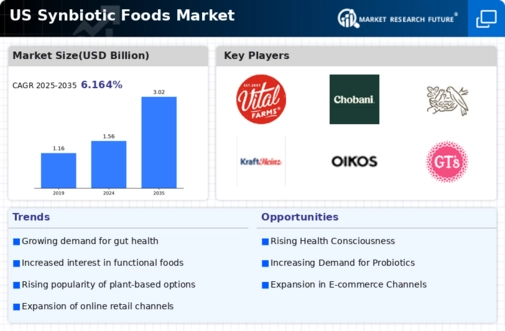Increased Awareness of Gut Health
The heightened awareness surrounding gut health is significantly influencing the synbiotic foods market. Consumers are becoming more informed about the role of gut microbiota in overall health, leading to a surge in demand for products that promote digestive wellness. Research indicates that approximately 70% of consumers are actively seeking foods that support gut health, which directly benefits the synbiotic foods market. This trend is further supported by educational campaigns and health professionals advocating for the consumption of synbiotics as a means to enhance gut flora, thereby driving market growth.
Innovations in Product Development
Innovative product development is a critical driver for the synbiotic foods market. Manufacturers are increasingly focusing on creating diverse and appealing products that cater to various consumer preferences. This includes the introduction of synbiotic yogurts, beverages, and snack bars that not only taste good but also provide health benefits. The market is witnessing a surge in the launch of new products, with a reported increase of 15% in new synbiotic food products in 2025 alone. Such innovations not only attract health-conscious consumers but also expand the market reach, suggesting a dynamic growth trajectory for the synbiotic foods market.
Rising Demand for Functional Foods
The increasing consumer inclination towards functional foods is a notable driver for the synbiotic foods market. As individuals become more health-conscious, they seek products that offer additional health benefits beyond basic nutrition. This trend is reflected in the market, where the functional food segment is projected to grow at a CAGR of approximately 8% from 2023 to 2028. Synbiotic foods, which combine probiotics and prebiotics, are particularly appealing as they support gut health and overall well-being. The growing awareness of the link between gut health and immunity further propels this demand, indicating a robust future for the synbiotic foods market.
Regulatory Support for Health Claims
Regulatory support for health claims related to probiotics and prebiotics is a significant driver for the synbiotic foods market. In the US, the FDA has established guidelines that allow manufacturers to make health claims about the benefits of synbiotic foods, provided they meet certain criteria. This regulatory framework not only enhances consumer trust but also encourages manufacturers to invest in research and development. As a result, the market is witnessing an increase in products that can substantiate health claims, potentially leading to a growth rate of 10% in the synbiotic foods market over the next few years.
Growing Interest in Personalized Nutrition
The trend towards personalized nutrition is emerging as a key driver for the synbiotic foods market. As consumers increasingly seek tailored dietary solutions that meet their specific health needs, synbiotic foods offer a unique proposition. These products can be customized to include specific strains of probiotics and prebiotics that align with individual health goals. The market for personalized nutrition is expected to reach $11 billion by 2026, indicating a substantial opportunity for synbiotic foods to cater to this demand. This shift towards personalization is likely to enhance consumer engagement and loyalty within the synbiotic foods market.






















Leave a Comment